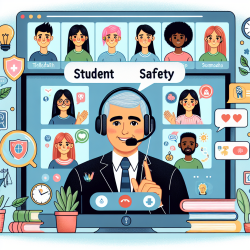Ensuring the safety of students in online therapy is paramount for mental health professionals working in schools. With the rise of telehealth services, it's crucial to implement best practices to protect and support our students effectively. Here’s a detailed guide to help you navigate this important aspect of your work.
Understanding the Importance of Safety in Online Therapy
Safety in online therapy encompasses both physical and emotional well-being. As mental health professionals, we must ensure that our students feel secure, respected, and heard during their sessions. Here are some key areas to focus on:
- Confidentiality: Ensure that all sessions are conducted in a private setting where the student feels safe to share openly.
- Data Security: Use secure, encrypted platforms for telehealth sessions to protect sensitive information.
- Emergency Protocols: Have clear procedures in place for handling emergencies, including having contact information for local resources.
Best Practices for Ensuring Safety in Online Therapy
Adopting best practices can help create a safe and supportive environment for students. Here are some recommendations:
1. Establish Clear Boundaries and Expectations
At the beginning of the therapy relationship, set clear boundaries and expectations with your students. This includes discussing the confidentiality of sessions, the appropriate use of technology, and what to do if they feel uncomfortable or unsafe.
2. Use Secure Technology
Choose a telehealth platform that complies with privacy laws such as HIPAA. Ensure that all communications are encrypted and that your platform has robust security measures to protect student data.
3. Create a Safe Physical Environment
Encourage students to find a quiet, private space for their sessions. If they are participating from school, work with the administration to ensure they have a designated area that is free from interruptions.
4. Develop Emergency Protocols
Have a plan in place for emergencies. This should include:
- Contact information for local emergency services and mental health resources.
- A protocol for assessing risk and determining the appropriate level of intervention.
- Steps for contacting a guardian or school administrator if necessary.
5. Foster a Trusting Relationship
Building trust is essential in any therapeutic relationship. Be consistent, reliable, and empathetic. Show students that you are there to support them and that their safety and well-being are your top priorities.
Addressing Challenges in Online Therapy
While online therapy offers many benefits, it also comes with its own set of challenges. Here are some common issues and how to address them:
1. Technical Difficulties
Technical issues can disrupt the flow of therapy and make students feel frustrated or anxious. To minimize these disruptions:
- Ensure both you and your student have a stable internet connection.
- Familiarize yourself with the telehealth platform and be prepared to troubleshoot common issues.
- Have a backup plan, such as switching to a phone call if video is not working.
2. Maintaining Engagement
It can be challenging to keep students engaged in an online setting. To maintain their attention:
- Use interactive tools available on your telehealth platform.
- Incorporate activities and exercises that are engaging and relevant to the student’s needs.
- Check in regularly to ensure they are following and understanding the session.
3. Addressing Privacy Concerns
Students may be worried about their privacy during online sessions. To alleviate these concerns:
- Reassure them about the confidentiality of their sessions.
- Explain how the technology protects their information.
- Encourage them to voice any concerns they may have.
Taking the Next Step
Ensuring the safety of students in online therapy is a continuous process that requires diligence, empathy, and adaptability. By implementing these best practices, you can create a safe and supportive environment that allows your students to thrive.If you’re ready to enhance your approach to online therapy and ensure the highest level of safety for your students, consider exploring additional training or resources. At TinyEYE, we offer comprehensive support and tools designed to help you succeed in your role. Reach out to us today to learn more about how we can support you and your students.










